

Chinese Miners: New Gold Hills - For Students // Hands On History. 2014 will welcome in the Year of the Horse on the 31st January for Chinese New Year!
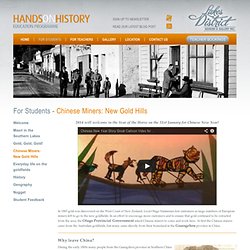
In 1865 gold was discovered on the West Coast of New Zealand. Local Otago businesses lost customers as large numbers of European miners left to go to the new goldfields. In an effort to encourage more customers and to ensure that gold continued to be extracted from the area, the Otago Provincial Government asked Chinese miners to come and work here. At first the Chinese miners came from the Australian goldfields, but many came directly from their homeland in the Guangzhou province in China. Why leave China? During the early 1800s many people from the Guangzhou province in Southern China lived in poverty. Www.taara.govt.nz/NewZealandPeople/Chinese/2/en.
The first immigrants – Chinese. Settlement policy In the 19th century, New Zealand’s settlement policy aimed to create a ‘fairer Britain of the South Seas’.
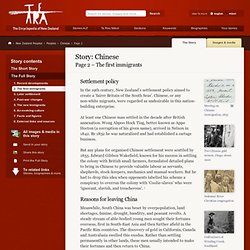
Chinese, or any non-white migrants, were regarded as undesirable in this nation-building enterprise. At least one Chinese man settled in the decade after British annexation. Wong Ahpoo Hock Ting, better known as Appo Hocton (a corruption of his given name), arrived in Nelson in 1842. By 1852 he was naturalised and had established a cartage business.
But any plans for organised Chinese settlement were scuttled by 1853. Reasons for leaving China Meanwhile, South China was beset by overpopulation, land shortages, famine, drought, banditry, and peasant revolts. 3. Later settlement – Chinese. The poll tax Although Chinese miners had been welcomed when there was a shortage of labour, anti-Chinese prejudice soon resurfaced.

By 1871 there were calls for Chinese immigration to be restricted. Like the other British colonies of Canada and Australia, New Zealand imposed an entry tax on Chinese immigrants. The Chinese Immigrants Act of 1881 introduced a ‘poll tax’ of £10. The act also imposed a restriction on ships’ passengers – one Chinese passenger per 10 tons of cargo. Chinese immigrants arrived under the credit ticket system, by which a guarantor – commonly a relative, village elder or prospective employer – advanced the fare and also the poll tax. Poll tax imposed on Chinese. China & New Zealand share long-term bond. China & New Zealand share long-term bond When Chinese visitors step into the New Zealand pavilion at Expo 2010 in Shanghai, they’ll become immersed in a culture that has more to do with their own background than many may realise.

The pavilion tells the story of Māori creation with a theme that looks at "cities of nature - living between land and sky" and for some Expo visitors it will be their first exposure to New Zealand and its culture. But for many Chinese the experience will be a strengthening of ties that have existed between the two countries for hundreds of years - close links that are still very evident in New Zealand today. Chinese in New ZealandChinese were some of New Zealand’s early and most prolific immigrants and now make up the fifth largest ethnic group in the country, with nearly 150,000 residents. Chinese culture is evident throughout New Zealand today and provides a colourful element to every day life and special events like food, art, music and sporting festivals.
New Zealand Chinese. Chinese Portraits. This exhibition is a small selection of photographs from the certificates of registration.
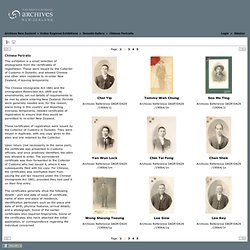
These were issued by the Collector of Customs in Dunedin, and allowed Chinese and other alien residents to re-enter New Zealand, if leaving temporarily. The Chinese Immigrants Act 1881 and the Immigration Restriction Act 1899 and its amendments, set out details of requirements to be met by aliens entering New Zealand. Permits were generally needed and, for this reason, aliens living in this country and departing overseas temporarily, needed certificates of registration to ensure that they would be permitted to re-enter New Zealand. These certificates of registration were issued by the Collector of Customs in Dunedin. They were issued in duplicate, with one copy given to the alien and one retained by the Collector. Upon return (not necessarily to the same port), the certificate was presented to Customs officials, and once positively identified, the alien was allowed to enter.
Date: 11/07/08. Funding and grants - Trust and fellowship grants - Chinese Poll Tax Heritage Trust - communitymatters.govt.nz. Background.
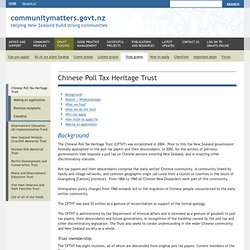
NZ Chinese Mission History. The Story of TheNew Zealand Chinese Mission 1867 to 1952 The title image portrays Tang Yin Ling of Horseflat, Macraes, Central Otago, returning home after collecting his supplies.
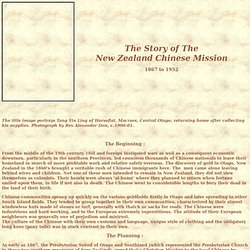
Photograph by Rev Alexander Don, c.1900-01. The Beginning : From the middle of the 19th century, civil and foreign instigated wars as well as a consequent economic downturn, particularly in the southern Provinces, led countless thousands of Chinese nationals to leave their homeland in search of more profitable work and relative safety overseas. Chinese communities sprang up quickly on the various goldfields firstly in Otago and later spreading to other South Island fields. Tales of New Zealand Chinese History.